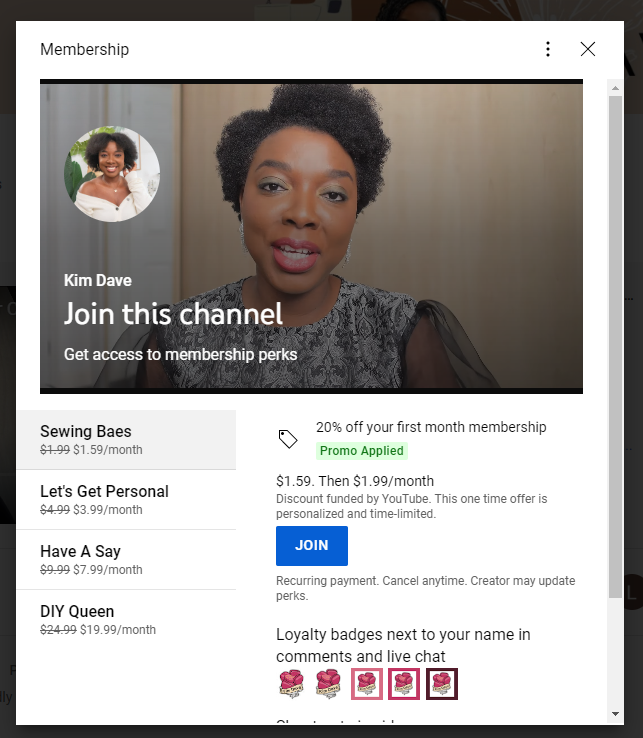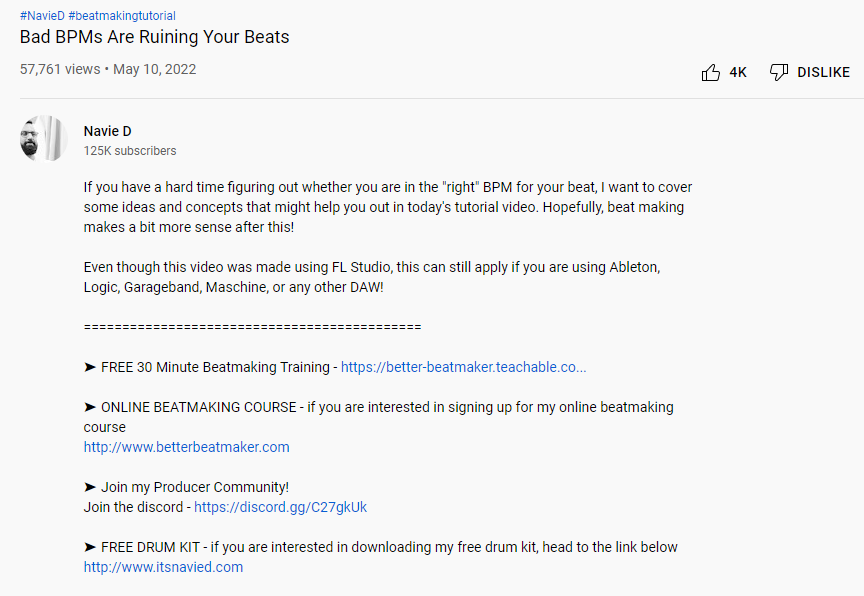Trying to figure out how to make money on YouTube?
5 ways to make money on YouTube (that actually work)
Monetizing content on any platform as a creator is tricky. YouTube is no exception.
Creators shouldn’t sacrifice entertainment value or authenticity for dollars and cents.
The good news? There is no “right” or “single” way to monetize your videos. You have multiple options based on your content, audience and promotional strategy.
Let’s dive into five opportunities to make money on YouTube and how they work.
1. Join the YouTube Partner Program
No surprises here! The YouTube Partner Program allows creators to earn revenue with ads run on their videos.
Let’s look at a quick snapshot of YouTube’s Partner criteria. Assuming you’re in line with the platform’s monetization policies, you need:
- 4,000+ authentic public watch hours within the past year
- 1,000+ subscribers
- An active and linked Google AdSense account
Chances are you’ve seen your fair share of YouTube ads. Given that YouTube saw a 25% YoY increase in ad revenue last year, you’re not alone.
From in-video to pre-roll, ads are a relatively hands-off way to make money on YouTube.

In terms of how much money you can make from ads, there are too many variables for a straight answer. These variables include:
- Your viewers’ demographics such as location and age
- Whether there are relevant advertisers for your videos
- Your content and industry
According to YouTube themselves, there are “no guarantees” for payouts or revenue share. Most information floating around is totally anecdotal.
While “$1 per 1,000 views” used to be the norm, times have changed. As the YouTube algorithm has evolved, so have the Partner Program and ad policies. For example, the platform has explicit restrictions for advertising on YouTube Kids. Many major ad categories and targeting features are removed from videos intended for children.
You’re essentially looking at a numbers game regardless. You need to be earning thousands (or millions) of views per video to see any meaningful revenue.
Not sure about running ads on your channel? Totally understandable. Again, monetizing videos shouldn’t hold back your channel’s growth.
Stuffing your videos with unskippable ads makes them borderline unwatchable. That said, a few ads here and there is totally fair game.
2. Earn support from subscribers with a Channel Membership
YouTube’s Channel Memberships are specifically designed to support creators looking to make money.
Think of Memberships like a Patreon or Twitch subscription. Subscribers pay a monthly fee in exchange for channel-specific perks. This might include exclusive content, chat badges and more. These benefits vary based on your Membership tier.

This feature is most relevant to creators that primarily post content to YouTube rather than treat it as a secondary channel. If you’re doing regular live streams or posting daily, Memberships make perfect sense. Currently, the eligibility for Channel Memberships is almost identical to the Partner Program.
3. Put promotional links in your video descriptions
Promo links are a low-hanging way to make money on YouTube without running ads.
Your video descriptions are valuable real estate and YouTube gives you 5,000 characters to work with. Funneling your YouTube viewers to relevant links is a no-brainer. For example, a creator might link to:
- A lead magnet (such as a free course or downloadable resource)
- Their website
- Their merchandise or ecommerce shop
Below is an example of how creators can promote their own products in a video description. If nothing else, links can turn YouTube traffic into on-site traffic.

You’ll also commonly see creators put affiliate links in their video descriptions. The idea here is simple. You discuss products in your videos and then provide a direct way for viewers to check them out.
This tactic is extremely popular among review channels and creators making “how-to” content. For example, this video from MyLifeOutDoors breaks down tips for getting better sleep while camping…

…and provides affiliate links to the products mentioned in the video.

See how that works? The key here is that the products themselves are not the sole subject of the video. Some creators call out their affiliate links within their content and others don’t. The choice is yours!
Note: Affiliate links are totally allowed and don’t violate YouTube’s TOS. However, the platform does have an explicit policy for external links. Make sure to review YouTube’s guidelines before dropping links in your videos.
4. Feature sponsors in your videos
Sponsored YouTube videos are popular among big and up-and-coming creators alike.
Through sponsored content, you’re specifically promoting a brand within your video. These call-outs are typically done at the beginning and end of a video. Since these forms of ads are literally part of your content, they can’t be skipped.

In the example above, Binging with Babish’s Andrew Rea bookends his sponsorship from Cash App at his video’s beginning and end. He also highlights the sponsorship in the video description.

Audiences are sometimes critical of sponsored videos when the sponsorship is totally irrelevant to the creator, their content or viewership. The best sponsored videos represent some sort of creative tie-in that doesn’t distract from the creator’s style. This sponsored video from Beauty Within featuring skincare brand Whind is a good example.

These sorts of promotions are a win-win for creators and advertisers alike.

5. Publish product-focused promotional videos
Branded videos are created with the specific intent to promote a product or service. These videos can fall into a few categories where:
- A brand compensates the creator in exchange for their content or a review
- The brand has provided talking points and instructions to the creator (think: influencer or brand ambassador content)
- The creator is making a video to highlight a brand and earn affiliate revenue
These types of videos are common among beauty and skincare brands where creators unbox PR packages on camera.

Below is another example from a creator going into detail about Liquid IV and how it works.

In the video’s description, the creator’s promotional link is front-and-center.

These types of videos aren’t as common because they can feel a bit direct when it comes to promotion. That said, they’re relevant to industries like beauty, health and fitness where audiences like to hunt for products via YouTube.
Making money on YouTube: Fast facts and FAQ
To wrap things up, let’s look at some common questions we get from people trying to figure out how to make money on YouTube.
How many views do you need to make money on YouTube?
There is no set amount of views you need to make money on YouTube.
Again, there are a lot of variables involved and dollar figures are anecdotal.
Data from Influencer Marketing Hub notes that YouTubers can make $18 per 1,000 ad views which translates to $3 to $5 per 1,000 video views.
Creator Shelby Church shared an in-depth breakdown of a video that earned 2.2 million views and $743 from ads. This equates to about 33 cents per 1,000 views. She notes that factors like presentation, age and demographics of viewership impacted the payout.

In short, more YouTube views don’t always equal more money in your pocket.
How many subscribers do you need to make money on YouTube
There is no exact number of subscribers you need to make money on YouTube.
Creators that make careers out of YouTube are the ones uploading consistently and fostering communities.
Piggybacking on the point above, a higher subscriber count doesn’t automatically result in bigger payouts.
The inner workings of YouTube’s ad platform mean there is no “right” answer here. We can use YouTube tools like SocialBlade to give us a ballpark figure but the range of estimated earnings is massive. For example, the monthly earnings estimation for a creator with 90,000 subscribers is anywhere between $200 and $3,400.

Our advice? Don’t look at your subscribers as dollar signs. Focus on fostering a community before worrying too much about monetization.
How to make money on YouTube without posting videos
While it’s technically possible to make money on YouTube without posting videos, it’s definitely not the ideal way to approach YouTube.
Think about it. Brands don’t grow on Instagram by only posting on TikTok and vice versa. Every platform has different content types, styles and expectations. YouTube is the same way.
Sure, there are some steps you can take such as repurposing or cross-posting content to YouTube. This includes:
- Republishing Reels or TikToks as YouTube Shorts
- Taking webinars, presentations or slideshows and turning them into videos
- Taking streams from Twitch or Instagram Live and uploading them as long-form content.
Note: Speaking of Shorts, creators should be aware of the YouTube Shorts Fund. This is a $100 million fund dedicated to encouraging creators to post original shorts. The keyword here is original, though! Cross-posting content likely won’t get you there.
If you want to make money on YouTube, you need to grow your presence first
Making any level of income from YouTube requires conscious effort and consistency.
That said, countless content creators are making it happen with their content. Whether through ads or sponsorships, there are plenty of opportunities to monetize your videos. Hopefully, these tips can help you find a way that makes sense for you!
And if you haven’t already, check out our in-depth guide to YouTube marketing to take your channel to the next level.
The post How to make money on YouTube (and what creators should expect) appeared first on Sprout Social.
from Sprout Social https://ift.tt/BF0GvQo
via IFTTT
No comments:
Post a Comment